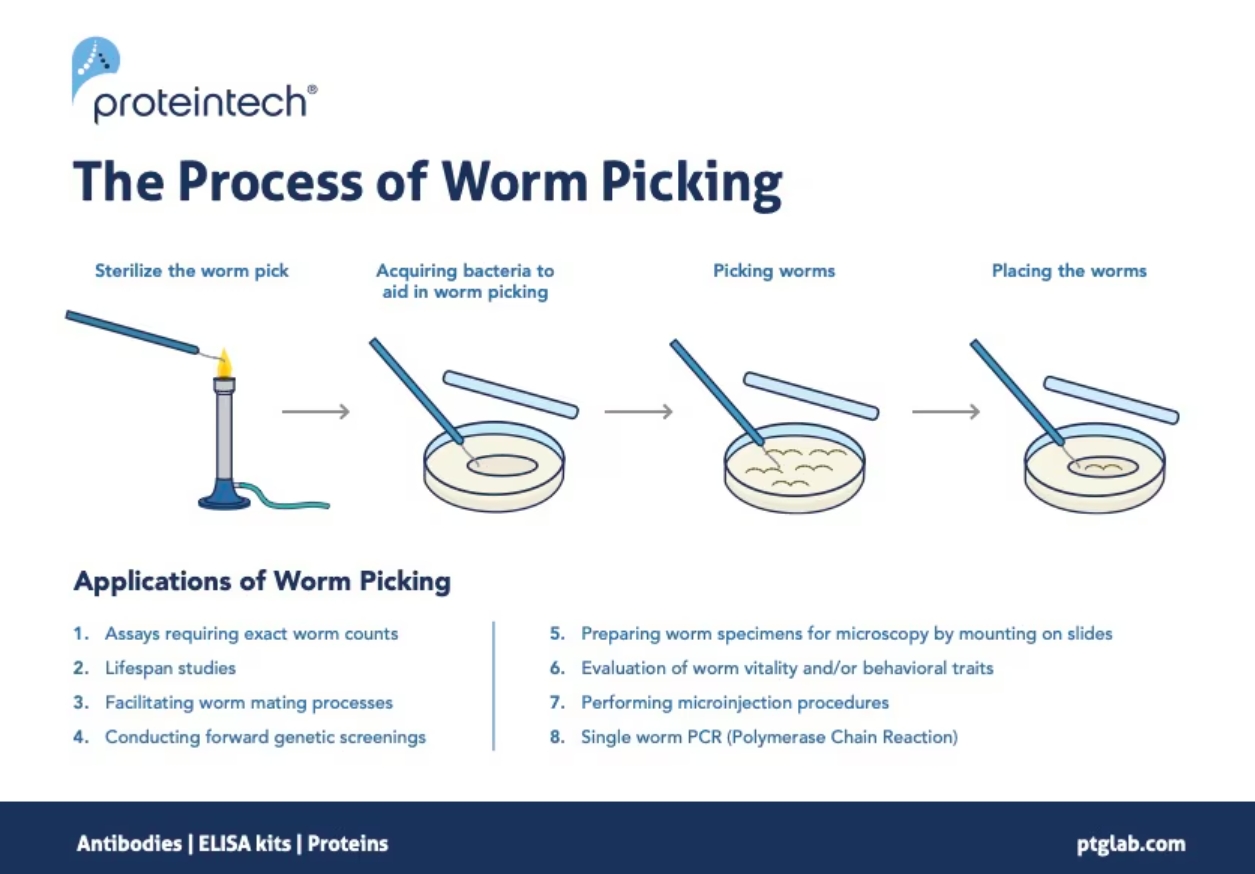線虫実験ナビ:線虫のピッキングを成功させるヒント
Levon Tokmakjian著(Toronto大学、PhD Candidate)
線虫のピッキング(Worm picking)は、線虫(C. elegans)を扱う研究者にとっての基礎スキルです。順遺伝学的スクリーニング、行動解析、線虫の交配、ストック線虫の汚染除去、マイクロインジェクション等の様々な用途で使用するため、線虫のピッキング手技の習得は、様々な実験を実施するうえで極めて重要な意味を持ちます。本稿では、自身の経験に基づいた、線虫の取り扱いを習熟するために役立つ知見やポイントを紹介します。

図1. 線虫のピッキング手順
用意するもの:
手順の詳細を解説する前に、まずは必要な器具を揃えておきます。
線虫研究者が通常用意しておくものは次の通りです。
-
回収する線虫がいるプレート
-
線虫ピック(研究機器の販売代理店やECサイトから購入可能です。自作することもできます)
-
実体顕微鏡(明視野観察)
-
ブンゼンバーナーまたはエタノールランプ
-
線虫を移すプレート
必要な器具を揃えたら、以下の手順に従い線虫をピッキングしましょう(図1)。線虫を扱う際に重要なポイントと手技も併せてご紹介します。
線虫のピッキング
ステップ1:ピックの滅菌
線虫のピッキングを開始するにあたり、最初に実施するのはピックの準備と滅菌です。市販されているピックを使用する場合であっても、自作したピックを使用する場合であっても、ピッキングに使用する白金線は滅菌する必要があります。白金固有の特性である熱しやすく冷めやすい性質によって滅菌のステップは短時間で完了しますが、この滅菌作業は極めて重要なステップです。数秒間炎で炙ることで、付着している可能性のある汚染物質を確実に除去し、ピッキング後に行う実験の完全性を担保します。
ステップ2:線虫の回収(ピッキング)
滅菌済みのピックを手に、線虫のピッキング作業を開始します。1回のピッキングで回収できる線虫の数は、ピックの幅によって異なります。線虫のピッキング作業を円滑に行うための有用なポイントとしては、最初にピックで大腸菌培地表層を拭う(swipe)ことが挙げられます。こうすることでピックに付着した大腸菌が、線虫をピックに接着させるための「糊」の役割を果たします。ピッキング作業の際は、繊細な線虫を不用意に傷つけないために優しく取り扱います。慎重な筆遣いで線虫をやさしく持ち上げるようなイメージでピッキングします。線虫の捕捉に成功したら、線虫が乾燥するのを防ぎ、白金線を這い上がったりしないように、ただちに移動先のプレートに移し替えます。
ステップ3:線虫の移し替え
目的の線虫のピッキングに成功したら、続いて、別のプレートや実験のための所定の目的地へ線虫を移し替えます。ピックを培地の表層に軽く撫でつけるか接触させることで、線虫はピックから円滑に離れます。寒天培地に孔があると線虫が潜り込む可能性があるため、ピックで突いて孔を開けないように注意しましょう。
ステップ4:ピックの再滅菌
線虫を移し替えた後は、使用したピックを必ず再滅菌します。都度滅菌することで、ピックのコンタミネーションを防ぐとともに、複数の線虫を取り扱う場合に系統・株間のクロスコンタミネーションを防ぐことができます。ピックの滅菌を何度も繰り返すと煤が付着することがあるので、その際は拭き取りましょう。
ピックを自作する際のポイント
-
ピッキング用のピックは32ゲージの白金線とガラス製のパスツールピペットを使用して自作できます1。必要な安全対策を講じたうえで、白金線を切りとり(約2.5 cm)、切り取った白金線の一端を少しだけパスツールピペットに挿入します。白金線周辺のパスツールピペットを加熱しすぎないように注意して炎で軟化させ、軽く押さえつけて白金線を固定します。白金線の先端は、線虫を回収しやすいように平らにしたり、好みの形状に曲げる等、適切な形に調整します。線虫を傷つけないように、やすりがけ等をして鋭角的な箇所がないように加工しましょう。
-
白金線とパスツールピペットを用意する代わりに、まつ毛を爪楊枝に接着してピックを自作するというやや変則的な方法もあります2。まつ毛ピックは特定の行動解析アッセイに特に有用である一方、爪楊枝を完全に滅菌するのが困難な点が問題となる場合があります。
最後になりますが、線虫のピッキングは様々な研究用途に役立つ繊細で熟練を要する技術です。線虫を研究するにあたり、本稿で解説したヒントやテクニックは実践ガイドのような役割を果たし、多目的に利用可能な線虫の実験を成功させ、有意義な結果を得るための指針となってくれるでしょう。
参考文献
1. T Stiernagle. Maintenance of C. elegans. WormBook. 2006 Feb 11:1-11.


